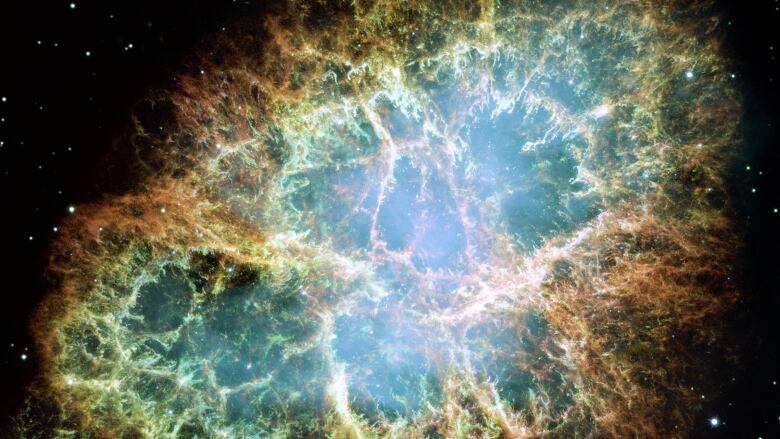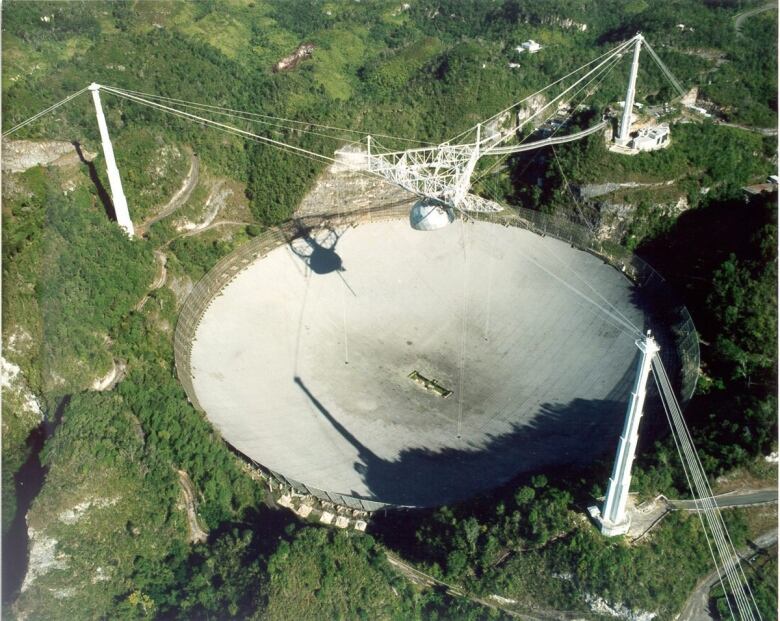Repeating mysterious radio bursts from deep space surprise scientists
First repeating fast radio bursts detected by McGill researcher raising new questions about origin

Mysterious radio blips from deep space, far beyond our galaxy,have puzzled scientists since the first one was discovered in 2001.
Now, a Canadian scientist and his international collaborators have detected repeat performances of a "fast radio burst" for the first time. That raises new questions and new possibilities about what might be causing them.
Fast radio bursts or FRBs single bursts of radio waves from outside our galaxy that last just one to 10 thousandths of a second were firstdetected just 15 years ago by scientists using a radio telescope in Australia.
- Neutron star researcher at McGillwins $1M Herzberg medal
- China will relocate 9,000 people to build world's biggest radio telescope
Since then, just 17 have been detected around the world, and all of them seemed to be one-offs, up until now.
Astrophysicists hadsuggested fast radio burstsmight be caused by a catastrophic event that destroys the source, which might be an object like a neutron star, saidPaulScholz, a Ph.D. student atMcGillUniversity in Montreal who studies FRBs.Neutron stars are "dead" or "zombie" stars that form when a massive star runs out of fuel and explodes in a supernova, but hasn't collapsed to the point of becoming a black hole.

He was analyzing data from the Arecibo radio telescope in Puerto Rico in 2013, using the university's supercomputers, when he spotted a fast radio burst that looked familiar. It was very much like one discovered in 2012 by Laura Spitler, now a postdoctoral researcher at the Max Planck Institute for Radio Astronomy in Bonn, Germany, and lead author of the paper about the new discovery.
"I knew right away it was from the same source," said Scholz, noting that it came from the same part of the sky in the constellation Auriga and appeared to be coming from the same distance away, about threebillion light years. That's far, far outside our Milky Way galaxy, which is about 100,000 light years wide.
Scholz is supervised by Victoria Kaspi, a professor whose entire research group is involved in similar research involving radio astronomy. Scholz isn't sure exactly what he shouted out when he spotted the repeat radio burst, but it soon brought the entire group running tohis desk.
10 repeats in total
Once the team'sinitial excitement died down, Spitler and her colleagueJason Hessels realized they needed more observations to check whether this was a fluke. They gathered another three months of data from the Arecibo telescope in 2015 andfound nine more similar fast radio bursts.

Based on the data from those 10 measurements, the researchers are now confident that the fast radio burst is repeating. They've also showed that some clump together six of them came within 10 minutes of each other,while four others were spread out.
That suggests the source is either only emitting bursts some of the time or only visible from Earth some of the time, Scholz says.
So what could be causing it?
Well, signals similar to fast radio bursts (but from much closer) have long been observed within our own galaxy from pulsars. They're neutron stars that emit beams of radio waves from their magnetic poles. From Earth, those beams are seen as regular pulses as they rotate, akin to the blinking of a lighthouse signal.
Pulsating pulsar?
Some pulsars such as the "crab pulsar" don't emit uniform pulses, but occasionally throw out giantpulses many times brighter than their normal pulses, Scholz said.
The researchers propose that the most likely source of the repeating fast radio bursts is a rotating neutron star like a pulsar, but much farther away, that occasionally blasts out very bright radio bursts.
The researchers published their observations, and their theory about what might be causing them, in the journal Nature today.
Scholz acknowledged that they're not the first researchers who have tried to find repeat fast radio bursts, but so far no one else has been successful.
That may be because repeat pulses from other sources are too faint to be seen with the telescopes used to observe them.
"The other possibility, which is kind of exciting," he added, "is that there are multiple classes of fast radio bursts."
Interestingly, a study led by researchers from Swinburne University in Technology in Australia announced last week in Nature that they had observed a fast radio burst that appeared to be linked to an afterglow that lasted six days. That suggestedit didn't comefrom a pulsar. The researchersproposed that their results may also mean there is more than one kind of fast radio burst.
Scholz and his collaborators are now trying to pinpoint the exact location of the source of their repeating fast radio bursts in an effort to identify what galaxy it's coming from.












_(720p).jpg)


 OFFICIAL HD MUSIC VIDEO.jpg)
.jpg)



























































































